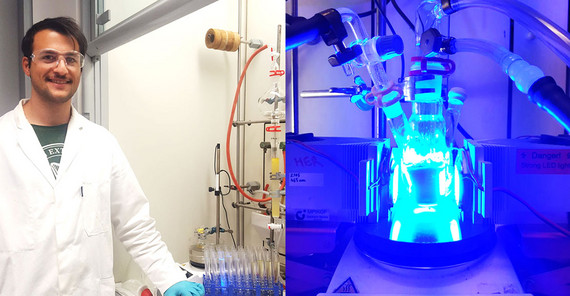In the field of catalysis, energy is used by a material - the catalyst - to transform simple molecules into a valuable product. This technology enables the production of huge amounts of fertilizers, plastics, and medicines that need to be provided for human development worldwide. Catalysts are based on precious metals that cannot be recycled and are expensive. The energy employed is provided by burning fossil fuels contributing to global warming. Therefore, it is necessary to find sustainable approaches for catalytic processes. Sunlight as an infinite energy reservoir enables photocatalysis as a powerful tool well known to plants, practicing it since the beginning of times as photosynthesis.
Organic carbon nitrides can act as recyclable, cheap, non-toxic, heterogeneous photocatalysts. They may use sunlight to disruptively shake the current state of the art with new unforeseen processes, as highlighted in the review Mazzanti et al., ChemPlusChem 2020. This material can indeed mimic and surpass photosynthesis. Light can be harvested to transform water and CO2 into alcohols and methane, namely the production of the fuels of the future within carbon neutrality (Mazzanti et al., Applied Catalysis B: Environmental 2021). Light can also be stored, thanks to the unique properties of carbon nitride, to work as “Solar Battery”, and used afterward for chemical transformations, like in plants’ Calvin cycle (Mazzanti et al., Exploration 2021). Furthermore, this material truly works as an artificial leaf, able to coat with thin-films objects of any kind via chemical deposition, to turn bare glassware in light-powered factories for chemicals (Mazzanti et al., ACS Catalysis, 2021). Finally, carbon nitride can also be used to develop methods to build novel pharmaceuticals to quickly face humankind’s challenges, such as COVID-19 (Mazzanti et al., Nature Communications 2020).
Stefano Mazzanti studied Chemistry at the University of Bologna and completed his PhD at the Max Planck Institute of Colloids and Interfaces and the University of Potsdam under the supervision of Dr. Aleksandr Savateev and Prof. Markus Antonietti. His outstanding scientific work during his PhD enabled breakthrough advancements in the state of the art of materials science, heterogeneous photocatalysis, and organic chemistry and resulted in the five above-cited, internationally renowned publications as first author. Currently, he is working for McPhy Energy Deutschland, developing electrolyzers for hydrogen production.
Publications:
S. Mazzanti, B. Kurpil, B. Pieber, M. Antonietti, A. Savateev, Nature Communications, 2020, 11, 1387, https://doi.org/10.1038/s41467-020-15131-0
S. Mazzanti, A. Savateev, ChemPlusChem, 2020, 85, 2499-2517, https://doi.org/10.1002/cplu.202000606
S. Mazzanti, S. Cao, K. ten Brummelhuis, A. Völkel, J. Khamrai, D.I. Sharapa, S. Youk, T. Heil, N.V. Tarakina, V. Strauss, I. Ghosh, B. König, M. Oschatz, M. Antonietti, A. Savateev, Applied Catalysis B: Environmental, 2021, 285, 119773, https://doi.org/10.1016/j.apcatb.2020.119773
S. Mazzanti, G. Manfredi, A.J. Barker, M. Antonietti, P. Giusto, A. Savateev, ACS Catalysis, 2021, 11, 11109-11116, https://doi.org/10.1021/acscatal.1c02909
S. Mazzanti, C. Schritt, K. ten Brummelhuis, M. Antonietti, A. Savateev, Exploration, 2021, 1, 20210063, https://doi.org/10.1002/EXP.20210063
Image: left: Dr. Stefano Mazzanti in the lab (credit: Yevheniia Markushyna), right: photocatalytic reactor (credit: Stefano Mazzanti)
Contact: Dr. Barbara Schneider, Faculty of Science, E-Mail: leibnizuuni-potsdampde
Internet: www.leibniz-kollegpotsdam.de
Media Information 25-10-2023 / Nr. 111

